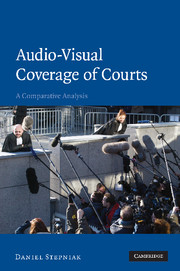Book contents
- Frontmatter
- Table of Contents
- Table of Legislation
- Table of Cases
- List of Abbreviations
- 1 Introduction
- 2 United Kingdom
- 3 Key American experiences
- 4 Canada
- 5 Australia
- 6 New Zealand
- 7 Comparative analysis of findings and conclusions
- Appendices
- 1: Persons Consulted
- 2: Guidelines for Electronic Coverage of Judicial Proceedings, Western Australian Courts (1996)
- Bibliography
- Index
2: Guidelines for Electronic Coverage of Judicial Proceedings, Western Australian Courts (1996)
Published online by Cambridge University Press: 27 October 2009
- Frontmatter
- Table of Contents
- Table of Legislation
- Table of Cases
- List of Abbreviations
- 1 Introduction
- 2 United Kingdom
- 3 Key American experiences
- 4 Canada
- 5 Australia
- 6 New Zealand
- 7 Comparative analysis of findings and conclusions
- Appendices
- 1: Persons Consulted
- 2: Guidelines for Electronic Coverage of Judicial Proceedings, Western Australian Courts (1996)
- Bibliography
- Index
Summary
In these guidelines where the context permits: ‘film’ includes still photography and photographs; ‘camera’ includes video and still cameras; ‘cover’ and ‘coverage’ means film or electronic cover or coverage and includes any recording or broadcasting using television, video, photographic or sound equipment.
Coverage of judicial proceedings is permitted only on order of the Presiding Judicial Officer, who may grant or refuse permission in his/her absolute discretion and on such terms and conditions as he/she sees fit.
Applications for permission to cover judicial proceedings should be made in writing through the Public Information Officer.
The Presiding Judicial Officer may at any time and from time to time in his/her absolute discretion limit, suspend or terminate coverage of the proceedings or prohibit the publication of material gathered by coverage of the proceedings and shall do so whenever the interests of justice require and whenever necessary to protect the dignity of the Court or to assure the orderly conduct of proceedings.
Partiesmust be given a reasonable opportunity to object to coverage of the proceedings or to any part thereof or to the continuation thereof.
Objections are to be made to the Presiding Judicial Officer and may be made orally or in writing before the commencement of the proceedings or at any stage.
- Type
- Chapter
- Information
- Audio-visual Coverage of CourtsA Comparative Analysis, pp. 423 - 424Publisher: Cambridge University PressPrint publication year: 2008



